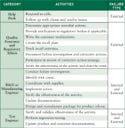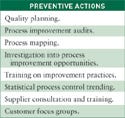Assessing the Cost of Poor Quality
Convincing OEMs to invest in preventive actions may be as simple as showing them the numbers. The key is to understand the costs associated with a poor quality system.
PRODUCT DEVELOPMENT INSIGHT
|
Olivier |
The further into the design or production process a defect is discovered, the more money it will cost a company to address the problem. Unfortunately, many company managers don't calculate the actual cost of correcting a defect. Therefore, they cannot calculate the savings that would have resulted by eliminating such defects throughout the design and manufacturing stages.
It is a challenge to quantify the benefits of investing in better design and manufacturing. It is even more of a challenge to demonstrate the financial effects of such an investment.
Quality system experts Armand Feigenbaum and Joseph Juran developed a model called the cost of poor quality (COPQ). This model quantifies the savings that result from design and manufacturing processes that are free of mistakes.1 Once companies quantify the costs of correcting defects, they can better understand the benefits of investing in quality improvement initiatives and can pursue quality improvement programs.
|
Singer |
There are three important assumptions in the COPQ model, as follows:
Each problem has a root cause.
Defects are preventable.
Manufacturers spend less money when they invest in prevention rather than correction.
When firms implement quality systems to reduce defects, they can also reduce design and development time, validation runs, rework during manufacturing, scrap, and inspection and testing processes.
|
Figure 1. (click to enlarge) Cost of poor quality trend for 17 months based on preventive action |
Figure 1 illustrates how investment in preventive actions can reduce the costs of external and internal failures and the costs associated with assessing failure. The chart shows how small investments in preventive action can have a much greater return in terms of reducing the cost of downstream defects (external and internal failures).
How to Determine COPQ
To calculate COPQ, firms need to determine the labor and material costs involved with external failures, internal failures, appraisal costs, and investment in preventive action. OEMs should take these four expense categories into account.
External Failures. Include all costs associated with addressing defects for products that have left the manufacturer's control, such as those found by customers or users of the device. Costs associated with servicing devices in the field, addressing complaints, filing and addressing corrections for medical device reports, and field corrective actions are included.
Internal Failures. Include all costs associated with addressing defects identified internally during development and production. These include inadequate testing, incorrect test documentation, improper validation activities, unclear requirements, and design and implementation defects. Defects discovered during incoming inspection, in-process testing, and final acceptance testing are also in this category.
Appraisal. Costs associated with inspection to identify defects that occur during product development and production, as well as errors in a manufacturer's quality system, make up this category. As a manufacturer experiences more defects, the costs for appraisal typically increase. Included in this category are expenditures incurred for the review of quality records and internal audits, the review of system specifications, and the review and inspection of manufacturing processes.
Preventive Actions. OEMs should account for costs associated with any process improvement program to understand customer requirements. Include surveys, prototypes, and voice-of-the-customer analyses. Other types of preventive actions are internal quality training programs and techniques to reduce design defects such as review checklists, defensive design training, and the use of automated design and test tools. Process redesign, increased process validation capabilities, use of higher-reliability components, and use of suppliers with more-mature quality systems are contained in this category.
Calculating COPQ
When calculating COPQ, manufacturers should compute the corrective actions for failures, and then address costs derived from quality assurance and quality control activities. An Excel spreadsheet using detailed formulas is available from the authors.
Corrective Actions for Failures. The same method is used to assess the cost to correct both internal and external failures. The differences in the calculations are the specific types of defects, activities, and personnel required to address internal, as opposed to external, failures.
|
Table I. (click to enlarge) Categories of external and internal failures. |
For each corrective action for failures listed in Table I, use the relevant activities listed in Table II. Following these seven steps determines COPQ.
Estimate the hours required for each labor category to address the corrective action for the failure.
Obtain the labor rate for each category of personnel.
Calculate the total labor cost as the sum of each personnel category (rate multiplied by hours).
Estimate the cost of materials for each corrective action, including scrap and required manufacturing materials.
Add the total labor cost and the material cost to get the estimated total cost per corrective action.

Table II. (click to enlarge) Activities to correct internal and external failures.
Estimate the number of these corrective actions experienced per year.
Multiply the total cost per corrective action by the estimated number of those actions per year to get the annual estimated total cost for addressing this type of activity (see Table III).
Appraisal Activities. For each sample activity listed in Table IV, perform the following four steps:
Identify relevant labor categories that perform appraisal.
Estimate the full-time equivalent number of personnel for appraisal activities.
Obtain the appropriate labor rate for each category.

Table III. (click to enlarge) Sample cost table for corrective actions for external and internal failures.
Calculate the total labor cost as the sum of each of the labor categories (salary multiplied by the number of equivalent full-time personnel).
Preventive Actions. For each sample activity listed in Table V, perform the following four steps:
Identify the personnel who would be involved in that activity.
Estimate the hours required in each labor category to participate in the activity.
Obtain the labor rate for each category of personnel.
Calculate the total labor cost as the sum of each personnel category (rate multiplied by hours).
|
Table IV. (click to enlarge) Sample appraisal activities. |
To obtain the COPQ, add the total costs of external and internal failures, as well as appraisal and preventive actions.
Limitations and Challenges
COPQ is not without its limitations. Although the dollar value calculated by COPQ may appear to be high, it still does not represent all of the costs that a firm incurs from external and internal defects. It does not take into account opportunity costs such as increased time to market, wasted factory space, and poor customer reputation costs.
|
Table V. (click to enlarge) Sample preventive activities. |
Firms that use COPQ calculations may run into roadblocks when gathering data, but there are often ways to overcome those difficulties. For example, the quality manager needs to get accurate labor rates from the finance department. If accurate labor rates are not available, the quality manager can use a general hourly fully loaded labor rate. U.S. firms that opt for this route can use the rate of $100 per hour, or $200,000 per year, for full-time personnel.
Manufacturers must also guard against problems when initiating a program to calculate COPQ. To do so, adopt a strategy that incorporates the five steps outlined below.
Get an Accurate Picture of Real Costs. At times, various groups or individuals within a company feel threatened by revealing the amount of money that has been lost when correcting internal and external failures. This fear motivates them to conceal some actual costs. By focusing on quantitative data, rather than blaming various individuals, companies can be confident that the real costs have been captured. By taking such an approach, staff will be more likely to participate in the process.
Gain the Buy-In of Top Management. It is essential to get top management to buy into the COPQ approach. One way to gain their support is to ensure that the basis for the model is understood. Management that recognizes that the model is based on quantitative cost data is more receptive to participating in a COPQ initiative. With COPQ results, managers are better prepared to decide which quality improvement initiatives can provide the greatest return in cost savings and quality improvement.
Tailor the Program. Each company's ability to determine preventive actions is unique. Company executives must take time to assess cost categories, labor rates, and defect levels to gain a realistic estimate of their company's capabilities.
Adequately Train Employees. Employees must be trained on COPQ principles, background, and assumptions. As a firm trains its employees, the employees often see the benefits of the model and contribute to modifying their processes for increased quality and efficiency.
Estimate Costs Conservatively. To be credible, managers should estimate all costs conservatively and should not attempt to quantify opportunity costs.
An Ounce of Prevention
The main purpose of calculating COPQ is to define preventive actions that can reduce defects and enhance overall product quality. Preventive actions include improving product quality and manufacturing processes, instituting project postmortems, and creating a culture of continuous improvement.
Product Quality Improvements. One product quality preventive-action initiative includes enhancing user interfaces to make a product easier to use and to reduce complaints. Tasks also include increasing the reliability of components and parts to reduce field failures and minimize product recalls. Improving design practices and conducting more-thorough testing to reduce defects in the field are also benefits of preventive initiatives.
Manufacturing Process Improvements. Preventive-action initiatives for manufacturing processes include incorporating mistake proofing (e.g., poka-yoke) to reduce operator errors and instituting more-thorough validation practices to ensure increased process capability. OEMs can also use design of experiments to ensure that processes operate at optimum settings and employ process mapping to ensure that processes focus on the correctness of critical parameters and essential interfaces.
Project Postmortems and Institutional Learning. Companies can learn from designing and developing new products and from refining their manufacturing processes. Quality managers should examine preventive actions in recent product and process redesigns to discover the techniques that were the most effective in reducing costs and enhancing quality. Quality managers should also examine recent activities including corrective and preventive actions. Such information should be shared with employees and with other corporate manufacturing sites.
Continuous Improvement. Companies need to implement a culture of continuous improvement. When all employees understand the cost of defects and the benefits of investing in preventive actions, the original estimates for bottom-line savings will likely be exceeded.
Conclusion
The COPQ approach is an excellent tool to identify the preventive actions that reduce costs and improving quality. Many companies have used COPQ, from simplistic models that track recalls and complaints to more-elaborate ones that trace detailed costs associated with a wide range of labor categories. In all cases, use of the COPQ model has increased the emphasis on pursuing preventive actions. Best of all, COPQ speaks in the language of management—the language of money.
Success stories for manufacturers that have implemented the COPQ approach are numerous. For example, one medium-sized company was able to reduce its product quality costs from 9.3% to 6.8% of revenues by implementing a COPQ program. The firm had its appraisal costs reduced by $430,000, and its complaint costs were lowered by $536,000. Further, the amount of money the company spent on scrap and rework was reduced by more than $2 million.1
Manufacturers see real cost savings by implementing the COPQ model.
Dan Olivier is president of Certified Compliance Solutions Inc. He can be reached at [email protected]. Nancy Singer is president of Compliance-Alliance LLC. She is available via e-mail at [email protected].
Reference
1. Armand V Feigenbaum, Total Quality Control, 3rd ed. (New York: McGraw-Hill, 1991): 131.
Copyright ©2007 Medical Device & Diagnostic Industry
About the Author(s)
You May Also Like







